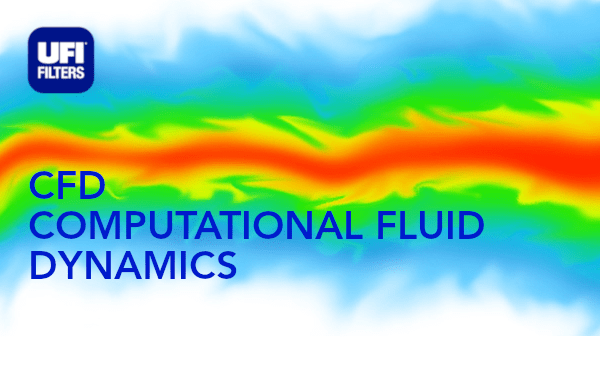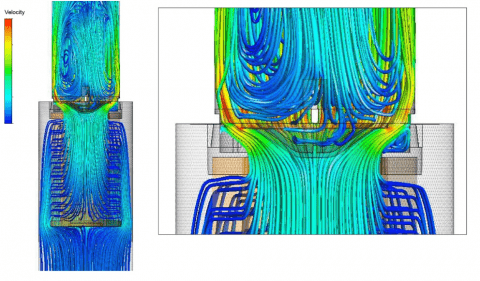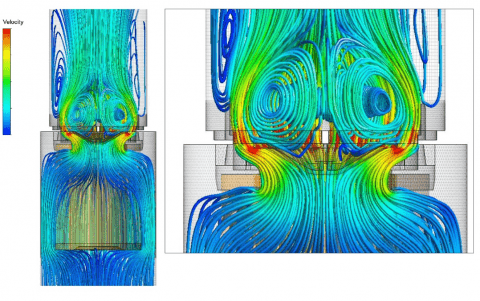
In response to the continuous demands for ever higher performance from the market, filter experts must identify the best compromise between the key factors pressure drop, filtration efficiency and dirt hold capacity.
To successfully optimize all three factors, it is necessary to analyse the performance of each component under different operating conditions, considering even the most challenging environments.
What is a CFD simulation tool?
The more experienced filter manufacturers are increasingly relying on CFD (Computational Fluid Dynamics) simulation tools that enable the user to “look into every corner of the filter”, which is often hard or even impossible to realize only by testing.
In addition, CFD offers the possibility of choosing conditions under which experimental testing is not usually possible (e.g. filter materials with different porosities, different temperatures and different viscosities), expanding the playing field for filter development.
CFD software allows optimization of the filter element.
This process leads to
- higher filter efficiency
- better utilization of the filter material
- system energy optimization thanks to a lower pressure drop
CFD software is also used for housing and assembly design, in particular for identifying the best bypass option in order to ensure leak-proof sealing at any pressure and a low pressure drop under full-flow conditions.
An example CFD simulation to solve cold-start problems
More and more often, in addition to the correct level of fluid cleanliness, the components of the hydraulic system must be designed such that optimal working conditions can be guaranteed even after scheduled machine downtime.
Specifically, one of the most requested requisites for filters installed on the suction line is the prevention of cavitation phenomena due to the emptying of the circuit after the vehicle has stopped.
To meet this increasingly widespread need, and in response to the specific request of an important tractor manufacturer, UFI Filters Hydraulics has developed, with the assistance of CFD analysis, an immersed filter, including an anti-drain valve.
The anti-drain valve prevents the filter from emptying when the engine is switched off and thus ensures that the necessary pressure is immediately available when the engine is restarted.
The aim of the investigation involving CFD technology was to estimate and compare the pressure drops across the filter element at two different temperatures: under cold start conditions at a temperature of −7° C, with a fluid viscosity of 1090 cSt, and under 43° C operating conditions, with a fluid viscosity of 55 cSt.
The UFI Filters Hydraulics CFD simulation in detail
Specifically, CFD (Computational Fluid Dynamics) analysis was used to optimize the valve and the geometry of the filter media, as it allowed us to estimate:
- The behaviour of the fluid within the circuit together with the direction and speed
- The pressure at each individual point in the fluid; in this case, the aim of the analysis was to minimize all the flow variation in order to limit the pressure drop
- Variations in flow velocity
- Variations in flow direction
The methodology for this type of analysis includes the following steps:
1. Preliminary analysis of the first version of the component.

2. The first analysis was crucial for identifying the critical issues and possible optimization areas. Based on the results of the first simulation, the geometry of the element was optimized with the aim of smoothing the flow as it passes through the valve.
3. The optimized component was then subjected to a second round of analysis.

New generation filter elements with CFD simulation technology
The CFD simulation analysis resulted in:
- A reduction in the vortices present before the flow enters the valve
- A better distribution of flow within the system
- Lower absolute flow velocities
The final result was a reduction in the overall pressure drop, which was what the customer had initially requested.
The analysis at room temperature was then validated by an experimental test.
This approach allowed UFI Filters Hydraulics to obtain an approximation of the flow behaviour and perform targeted optimizations. Furthermore, having validated the calculation model, it was also possible to simulate various conditions under which it is experimentally difficult to operate (high/very high viscosity fluid due to low temperatures) .
The suction filter with anti-drain valve engineered based on the CFD simulation analysis can be used not only in agricultural applications, but also with any type of machinery – both mobile and stationary – that requires frequent operational downtime.
For further information, please contact our sales team to identify the best solution for your application.